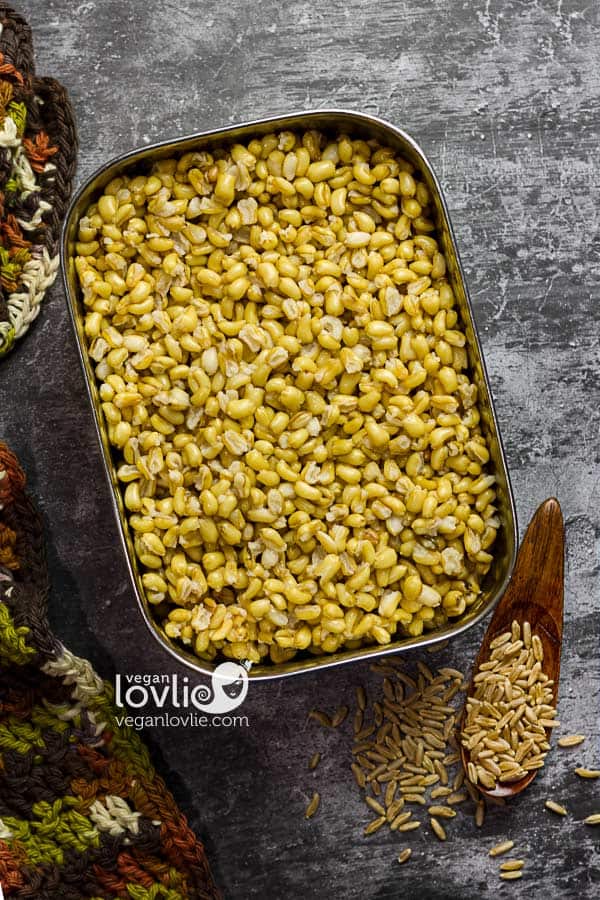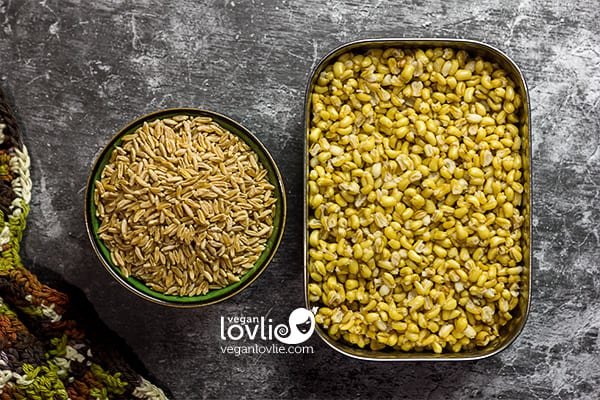Kamut is an ancient grain that is much easier to digest than conventional wheat. Kamut khorasan wheat has a better nutrient profile compared to modern wheat, with some anti-inflammatory properties too. Here’s some facts about Kamut khorasan wheat, where to find Kamut and how to cook it.

While doing some pantry Spring clean recently, rotating what’s stocked and using up leftovers of flours, grains and other foodstuffs that have been sitting in there for a while, I fell on a bag of Kamut grains. It was half full; I instantly remembered how I loved this ancient grain the first time that I cooked it.
I regularly make delicious homemade bread with Kamut flour (which you might have seen in my Instagram stories), but this little bag of grains had somehow escaped my attention for some time.
What is Kamut khorasan wheat?
Kamut, pronounce kah-MOOT, is an ancient grain which is a cousin of the wheat and also known as khorasan wheat. In fact, KAMUTⓇ is the brand name by which khorasan wheat grain and flour is sold. The word ‘kamut’ itself means wheat in ancient Egyptian language.
In appearance, the kamut grains or berries looks similar to brown rice only slightly more elongated, a little plumper with a distinct “hump”. When cooked though, they are much more gorged and juicier, similar to sweet corn kernels but chewier and with a rather sweet nutty flavour. Kamut has one of the most wonderful textures of grain that I’ve ever eaten!

Why should you eat Kamut?
Provided that you’re not wheat intolerant or on a grain-free diet, Kamut has a number of nutrients that makes it a great addition to the diet.
Khorasan wheat has got more protein, vitamins and minerals than regular wheat. A serving of ¼ cup dried Kamut (yielding ¾ cup cooked grains) contains:
160 calories | 32 g total carbohydrate | 1 g fat | 7 g protein
4 g dietary fiber (16 % of your daily needs)
4 g sugars
2% of your daily calcium
10% of your daily iron
* Percent Daily Values (DV) are based on a 2000 calorie diet. Your daily values may be higher or lower depending on your calorie needs.
It also contains a whole range of trace minerals, like selenium, zinc, and magnesium. Thanks to the magnesium content, which is an aiding factor in iron absorption, if you serve this grain with some dark, leafy greens, like in this Butternut Squash Gratin with Kamut Berries, you’ll benefit from better mineral absorption in the body.
In addition to these nutrition facts, unlike modern wheat, the KAMUT® trademark guarantees that the khorasan wheat bearing it is always the original, unmodified, unhybridized and non-GMO variety. KAMUT® khorasan wheat is also always grown certified organic and meets high purity, nutrition and quality standards.
Some studies claim that Kamut has anti-inflammatory properties. This is probably due to how the grain is grown as compared to conventional wheat, where notably the chemicals that are added may be what cause sensitivity and allergy-like symptoms in many non-celiac people.
This ancient grain has a different structure and is easier to digest by so many people with non-celiac wheat sensitivities who cannot eat modern wheat.
If you are celiac though, Kamut is not suitable for you as, although it’s easier to digest, it still contains gluten.

Where to buy Kamut?
I’ve been able to find Kamut at my local health store although I most often buy it online.
Kamut is less easy to find at regular grocery stores although Walmart in Canada carries it. Certain bulk stores might be a good place to look too.
Substitutes for Kamut
Although Kamut has a unique texture and flavour, it can be substituted in recipes that calls for it with ancient grains like:
- spelt berries
- Emmer wheat (farro)
- Einkorn
or other grains like wheat berries and oat groats.
How to cook Kamut grains?
Ingredients
- 200 g dried kamut grains, [1 cup]
- 720 ml water, [3 cups] more as required
- water for soaking
Instructions
- Soak the kamut grains in plenty of water for at least 12 hours or overnight.
- The next day, drain and rinse the grains.
To cook kamut on the stove top:
- Place the grains in a deep pot and add 3 cups fresh water. Bring to a boil then lower the heat to medium and simmer partially covered for about 40 minutes to 1 hour or until the grains are gorged and tender.
- You may need to add a little more water during the cooking, especially if you haven’t soaked the grains. Check occasionally and add water as required.
To cook the kamut in a pressure cooker:
- Add the grains and water to the cooker pot.
- Set the cooker at maximum pressure for 22 minutes. Once the time is up, let the steam go down naturally before opening the cooker.
- Drain the remaining liquid. The kamut grains are now ready to be used in recipes that call for cooked kamut berries.
Notes
Nutrition Facts
A serving of ¼ cup dried kamut (yielding ¾ cup cooked grains) contains: 160 calories | 32 g total carbohydrate | 1 g fat | 7 g protein 4 g dietary fiber (16 % of your daily needs) 4 g sugars 2% of your daily calcium 10% of your daily iron * Percent Daily Values (DV) are based on a 2000 calorie diet. Your daily values may be higher or lower depending on your calorie needs.Pin this post for future reference or just share the love.





I had only just recently tried kamut, in a vegan chili, of all things, and it was delicious. So I ordered a bag that came without instructions.
I came here for that, then saw your vegan grain and my mouth is absolutely watering. Now I’m down the rabbit hole browsing all of your vegan recipes and can’t wait to try them all. Your recipes and photos look absolutely fantastic. Thank you!
Sorry, autocorrect. *Gratin. Oops.
Do I need to soak the kaput before pressure cooking it? Thank you!